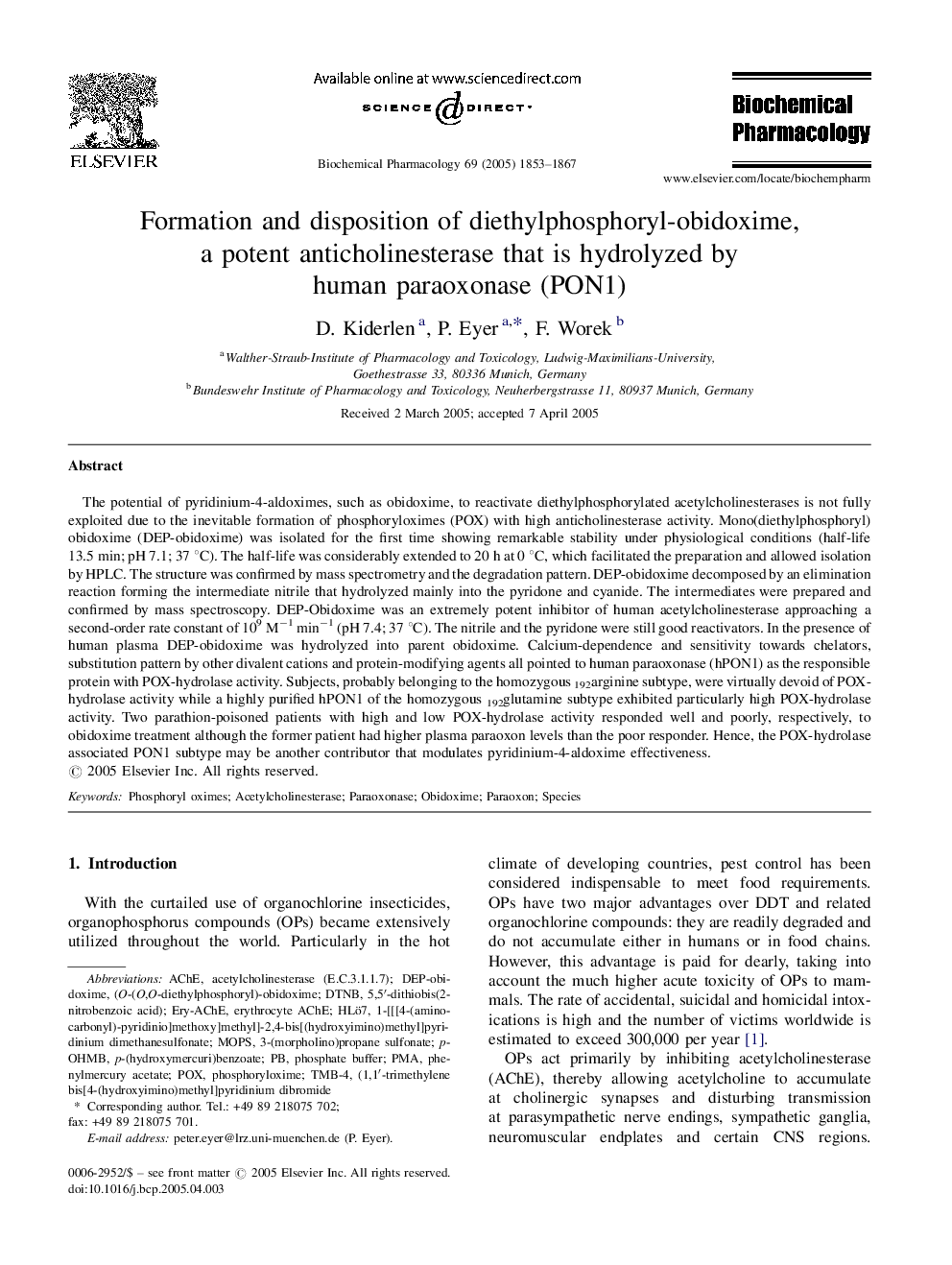| کد مقاله | کد نشریه | سال انتشار | مقاله انگلیسی | نسخه تمام متن |
|---|---|---|---|---|
| 9002040 | 1118569 | 2005 | 15 صفحه PDF | دانلود رایگان |
عنوان انگلیسی مقاله ISI
Formation and disposition of diethylphosphoryl-obidoxime, a potent anticholinesterase that is hydrolyzed by human paraoxonase (PON1)
دانلود مقاله + سفارش ترجمه
دانلود مقاله ISI انگلیسی
رایگان برای ایرانیان
کلمات کلیدی
موضوعات مرتبط
علوم پزشکی و سلامت
داروسازی، سم شناسی و علوم دارویی
داروشناسی
پیش نمایش صفحه اول مقاله

چکیده انگلیسی
The potential of pyridinium-4-aldoximes, such as obidoxime, to reactivate diethylphosphorylated acetylcholinesterases is not fully exploited due to the inevitable formation of phosphoryloximes (POX) with high anticholinesterase activity. Mono(diethylphosphoryl) obidoxime (DEP-obidoxime) was isolated for the first time showing remarkable stability under physiological conditions (half-life 13.5 min; pH 7.1; 37 °C). The half-life was considerably extended to 20 h at 0 °C, which facilitated the preparation and allowed isolation by HPLC. The structure was confirmed by mass spectrometry and the degradation pattern. DEP-obidoxime decomposed by an elimination reaction forming the intermediate nitrile that hydrolyzed mainly into the pyridone and cyanide. The intermediates were prepared and confirmed by mass spectroscopy. DEP-Obidoxime was an extremely potent inhibitor of human acetylcholinesterase approaching a second-order rate constant of 109 Mâ1 minâ1 (pH 7.4; 37 °C). The nitrile and the pyridone were still good reactivators. In the presence of human plasma DEP-obidoxime was hydrolyzed into parent obidoxime. Calcium-dependence and sensitivity towards chelators, substitution pattern by other divalent cations and protein-modifying agents all pointed to human paraoxonase (hPON1) as the responsible protein with POX-hydrolase activity. Subjects, probably belonging to the homozygous 192arginine subtype, were virtually devoid of POX-hydrolase activity while a highly purified hPON1 of the homozygous 192glutamine subtype exhibited particularly high POX-hydrolase activity. Two parathion-poisoned patients with high and low POX-hydrolase activity responded well and poorly, respectively, to obidoxime treatment although the former patient had higher plasma paraoxon levels than the poor responder. Hence, the POX-hydrolase associated PON1 subtype may be another contributor that modulates pyridinium-4-aldoxime effectiveness.
ناشر
Database: Elsevier - ScienceDirect (ساینس دایرکت)
Journal: Biochemical Pharmacology - Volume 69, Issue 12, 15 June 2005, Pages 1853-1867
Journal: Biochemical Pharmacology - Volume 69, Issue 12, 15 June 2005, Pages 1853-1867
نویسندگان
D. Kiderlen, P. Eyer, F. Worek,